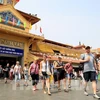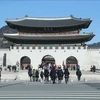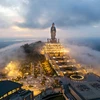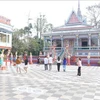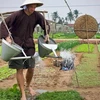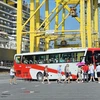 Recently, the train street in Hanoi has become a favourite hangout for domestic and foreign tourists. The two-km train street has railway tracks running from Le Duan, Tran Phu streets to Cua Dong and Phung Hung streets in the Old Quater, with residential buildings, barely feet away on either side. The highly unusual sight fascinates tourists. Domestic and foreign tourists have visited this 'street' for its uniqueness. Cafes have set up tables and chairs along the tracks, and tourists stand in the middle to take selfies. These unique coffee shops have created jobs for many people and become a must-visit spot in Hanoi. (Photo: VietnamPlus)
Recently, the train street in Hanoi has become a favourite hangout for domestic and foreign tourists. The two-km train street has railway tracks running from Le Duan, Tran Phu streets to Cua Dong and Phung Hung streets in the Old Quater, with residential buildings, barely feet away on either side. The highly unusual sight fascinates tourists. Domestic and foreign tourists have visited this 'street' for its uniqueness. Cafes have set up tables and chairs along the tracks, and tourists stand in the middle to take selfies. These unique coffee shops have created jobs for many people and become a must-visit spot in Hanoi. (Photo: VietnamPlus)  According to longtime residents, the street was a modern invention. This area used to be apartment buildings close to the railway, and over the years, these apartments deteriorated. Some even became places where drug addicts frequented. After some foreign tourists discovered this place around 2018, pictures they took widely circulated on the internet. Quickly catching up with the trend, some households have renovated and repaired the facades to turn them into coffee shops. The street, where trains travel along a track just inches from homes and businesses in the capital city, has long been one of Hanoi's most popular tourist sites. (Photo: VietnamPlus)
According to longtime residents, the street was a modern invention. This area used to be apartment buildings close to the railway, and over the years, these apartments deteriorated. Some even became places where drug addicts frequented. After some foreign tourists discovered this place around 2018, pictures they took widely circulated on the internet. Quickly catching up with the trend, some households have renovated and repaired the facades to turn them into coffee shops. The street, where trains travel along a track just inches from homes and businesses in the capital city, has long been one of Hanoi's most popular tourist sites. (Photo: VietnamPlus)  Tourists said it is a must to visit the street, have coffee or beer and wait for trains to pass. In 2019, Hanoi authorities shut down makeshift coffee shops along the train street and set up barriers to prevent tourists from entering the area to avoid accidents. Since Vietnam reopened international tourism and resumed pre-pandemic visa policies in mid-March, the train street has begun to revive with the return of foreign tourists. After the street reopened following the two-year closure, makeshift coffee shops resumed business along the rail tracks while many local and foreign tourists flocked to the area to take selfies. (Photo: VietnamPlus)
Tourists said it is a must to visit the street, have coffee or beer and wait for trains to pass. In 2019, Hanoi authorities shut down makeshift coffee shops along the train street and set up barriers to prevent tourists from entering the area to avoid accidents. Since Vietnam reopened international tourism and resumed pre-pandemic visa policies in mid-March, the train street has begun to revive with the return of foreign tourists. After the street reopened following the two-year closure, makeshift coffee shops resumed business along the rail tracks while many local and foreign tourists flocked to the area to take selfies. (Photo: VietnamPlus)  For a long time, the must-try place to enjoy coffee when travelling around the capital city has been recommended among foreign tourists. The National Geographic Traveler magazine has shared an interesting experience of the railway cafe neighbourhood in Hanoi. "An evening in Hanoi's train street, sipping on egg coffee... I love trains, and I am thrilled when one speeds past us. Afterwards, I talk to the woman who made my drink, and she shrugs. This is just normal for her." The status posted recently by NatGeo Travel on social media has received nearly 450,000 likes and many comments from users worldwide. (Photo: VietnamPlus)
For a long time, the must-try place to enjoy coffee when travelling around the capital city has been recommended among foreign tourists. The National Geographic Traveler magazine has shared an interesting experience of the railway cafe neighbourhood in Hanoi. "An evening in Hanoi's train street, sipping on egg coffee... I love trains, and I am thrilled when one speeds past us. Afterwards, I talk to the woman who made my drink, and she shrugs. This is just normal for her." The status posted recently by NatGeo Travel on social media has received nearly 450,000 likes and many comments from users worldwide. (Photo: VietnamPlus)  The street was ordered to close in late 2019, but after Vietnam reopened in March this year following two years of border closure, the coffee shops reopened, and foreign tourists have been flocking to the train street. The two-km train street has railway tracks running from Le Duan, Tran Phu streets to Cua Dong, Phung Hung streets in the Old Quarter, with residential buildings, barely feet away on either side. The highly unusual sight fascinates tourists. Cafes have set up tables and chairs along the tracks, and tourists stand in the middle to take selfies. The street has long been one of Hanoi's most popular tourist sites. (Photo: VietnamPlus)
The street was ordered to close in late 2019, but after Vietnam reopened in March this year following two years of border closure, the coffee shops reopened, and foreign tourists have been flocking to the train street. The two-km train street has railway tracks running from Le Duan, Tran Phu streets to Cua Dong, Phung Hung streets in the Old Quarter, with residential buildings, barely feet away on either side. The highly unusual sight fascinates tourists. Cafes have set up tables and chairs along the tracks, and tourists stand in the middle to take selfies. The street has long been one of Hanoi's most popular tourist sites. (Photo: VietnamPlus)  The shops must operate indoors and not infringe on the railway corridor. After Vietnam reopened in March following two years of border closure, more and more tourists flocked to Hanoi. The capital city has welcomed an estimated 10.62 million visitors in the first seven months of this year, an increase of 3.6 times over the same period last year. The municipal tourism department reported that total revenue from tourism activities is likely to reach 31.9 trillion VND (1.36 billion USD), up 3.9 times yearly. The capital served 1.94 million tourists in July alone, earning 6.15 trillion VND (263.3 million USD). (Photo: VietnamPlus)
The shops must operate indoors and not infringe on the railway corridor. After Vietnam reopened in March following two years of border closure, more and more tourists flocked to Hanoi. The capital city has welcomed an estimated 10.62 million visitors in the first seven months of this year, an increase of 3.6 times over the same period last year. The municipal tourism department reported that total revenue from tourism activities is likely to reach 31.9 trillion VND (1.36 billion USD), up 3.9 times yearly. The capital served 1.94 million tourists in July alone, earning 6.15 trillion VND (263.3 million USD). (Photo: VietnamPlus)  Hanoi's tourism sector is set to welcome 9-10 million visitors in 2022, including 1.2-2 million foreigners. Its total revenue is expected to reach 27.84 to 35.84 trillion VND. The city is focusing on developing tourism products of its strength, such as cultural and sports tourism and resort and MICE tourism, while strengthening connections in tourism development in potential areas. It has also enhanced communication activities promoting the image of the capital city, its tourism destinations and new products to visitors worldwide through programmes on Vietnam Television (VTV), HanoiTV, the US Cable News Network (CNN), and social network platforms. In photo: Domestic and foreign tourists visit the Hanoi train street. (Photo: VietnamPlus)
Hanoi's tourism sector is set to welcome 9-10 million visitors in 2022, including 1.2-2 million foreigners. Its total revenue is expected to reach 27.84 to 35.84 trillion VND. The city is focusing on developing tourism products of its strength, such as cultural and sports tourism and resort and MICE tourism, while strengthening connections in tourism development in potential areas. It has also enhanced communication activities promoting the image of the capital city, its tourism destinations and new products to visitors worldwide through programmes on Vietnam Television (VTV), HanoiTV, the US Cable News Network (CNN), and social network platforms. In photo: Domestic and foreign tourists visit the Hanoi train street. (Photo: VietnamPlus)  Coffee shop staff will inform visitors when a train is about to pass. The sections of track along the Hanoi-Dong Dang railway line, where trains pass close to residential houses, have been popular with tourists for many years. Over 30 household-based coffee shops along the train tracks run through Hang Bong, Cua Dong, Cua Nam, Hang Ma, and Dong Xuan wards. To ensure safety, coffee shops are not allowed to sell alcohol. Any shop that violates will be fined and ordered to close. These unique coffee shops have not only created jobs for many people but have also become a must-visit spot in Hanoi. (Photo: VietnamPlus)
Coffee shop staff will inform visitors when a train is about to pass. The sections of track along the Hanoi-Dong Dang railway line, where trains pass close to residential houses, have been popular with tourists for many years. Over 30 household-based coffee shops along the train tracks run through Hang Bong, Cua Dong, Cua Nam, Hang Ma, and Dong Xuan wards. To ensure safety, coffee shops are not allowed to sell alcohol. Any shop that violates will be fined and ordered to close. These unique coffee shops have not only created jobs for many people but have also become a must-visit spot in Hanoi. (Photo: VietnamPlus)  The street has railway tracks running from Le Duan, Tran Phu streets to Cua Dong, Phung Hung streets in the Old Quarter, with residential buildings, barely feet away on either side. The highly unusual sight fascinates both domestic and foreign tourists. Since Vietnam reopened in March, the street has again started drawing tourists. Cafes have set up tables and chairs along the tracks, and tourists stand in the middle to take selfies. Domestic and foreign tourists have visited this 'street' for its uniqueness. Many people even lie down on the railway tracks to pose for photos. However, it is also dangerous as the train track is still operational. (Photo: VietnamPlus)
The street has railway tracks running from Le Duan, Tran Phu streets to Cua Dong, Phung Hung streets in the Old Quarter, with residential buildings, barely feet away on either side. The highly unusual sight fascinates both domestic and foreign tourists. Since Vietnam reopened in March, the street has again started drawing tourists. Cafes have set up tables and chairs along the tracks, and tourists stand in the middle to take selfies. Domestic and foreign tourists have visited this 'street' for its uniqueness. Many people even lie down on the railway tracks to pose for photos. However, it is also dangerous as the train track is still operational. (Photo: VietnamPlus)  The street, where trains run along a track just feet from homes and businesses in the Old Quarter, has long been a popular tourist site and a regular favourite on social media. Once a quiet neighbourhood, the train street became famous when the sight of a train running through the heart of a densely packed residential area featured in foreign newspapers and magazines, especially in the US and the UK. Since then, people there have started decorating their homes and turned them into tourist-friendly cafés. Two foreign tourists take a selfie on the strain street in downtown Hanoi in the photo. (Photo: VietnamPlus)
The street, where trains run along a track just feet from homes and businesses in the Old Quarter, has long been a popular tourist site and a regular favourite on social media. Once a quiet neighbourhood, the train street became famous when the sight of a train running through the heart of a densely packed residential area featured in foreign newspapers and magazines, especially in the US and the UK. Since then, people there have started decorating their homes and turned them into tourist-friendly cafés. Two foreign tourists take a selfie on the strain street in downtown Hanoi in the photo. (Photo: VietnamPlus)  The sections of track along the Hanoi-Dong Dang railway line, where trains pass close to residential houses, have been popular with tourists for many years. The North-South railway in Vietnam was established in 1902 during the French colonial period. At some unknown time, people working in the railway industry started building houses along the line, gradually forming a small neighbourhood from Long Bien Station to the end of Le Duan Street. For over 30 years, many generations have lived in this place; children have been born and grown up with the clickety-clack of the steel wheels on the tracks. Photo: Foreign tourists in a café shop. (Photo: VietnamPlus)
The sections of track along the Hanoi-Dong Dang railway line, where trains pass close to residential houses, have been popular with tourists for many years. The North-South railway in Vietnam was established in 1902 during the French colonial period. At some unknown time, people working in the railway industry started building houses along the line, gradually forming a small neighbourhood from Long Bien Station to the end of Le Duan Street. For over 30 years, many generations have lived in this place; children have been born and grown up with the clickety-clack of the steel wheels on the tracks. Photo: Foreign tourists in a café shop. (Photo: VietnamPlus)  The street, where trains travel along a track just inches from homes and businesses in the Vietnam capital, has long been one of Hanoi's most popular tourist sites. There are currently around 30 families running cafes next to the street, which runs through Hang Bong, Cua Dong, Cua Nam, Hang Ma and Dong Xuan wards, according to Nguyen Anh Quan, Vice Chairman of the Hoan Kiem district People’s Committee. Tourists have flocked to the train street to get unique adventurous experiences. From Monday to Friday, the train only runs through the street once a day in the evening. Locals say when a train is about to arrive, they warn tourists to move off the tracks. (Photo: VietnamPlus)
The street, where trains travel along a track just inches from homes and businesses in the Vietnam capital, has long been one of Hanoi's most popular tourist sites. There are currently around 30 families running cafes next to the street, which runs through Hang Bong, Cua Dong, Cua Nam, Hang Ma and Dong Xuan wards, according to Nguyen Anh Quan, Vice Chairman of the Hoan Kiem district People’s Committee. Tourists have flocked to the train street to get unique adventurous experiences. From Monday to Friday, the train only runs through the street once a day in the evening. Locals say when a train is about to arrive, they warn tourists to move off the tracks. (Photo: VietnamPlus)  Most residents lived there before the Law on Road and the Law on Railway Safety came into force in 1990. Relocating households that are too close to the line would take much time and resources, and Hanoi has still not issued a decision on the matter, Quan said. Before COVID-19 broke out in early 2020, the district received complaints about the business model there. The official said the authorities deployed information campaigns and fined those who committed offences. After COVID-19 was under control and the country reopened, these businesses started to pop up again. In photo: Tourists take photos on the railway in the street. (Photo: VietnamPlus)
Most residents lived there before the Law on Road and the Law on Railway Safety came into force in 1990. Relocating households that are too close to the line would take much time and resources, and Hanoi has still not issued a decision on the matter, Quan said. Before COVID-19 broke out in early 2020, the district received complaints about the business model there. The official said the authorities deployed information campaigns and fined those who committed offences. After COVID-19 was under control and the country reopened, these businesses started to pop up again. In photo: Tourists take photos on the railway in the street. (Photo: VietnamPlus)  Many visitors spend hours enjoying the uniqueness of the street. In 2019, Hanoi authorities shut down makeshift coffee shops along the train street and set up barriers to prevent tourists from entering the area to avoid accidents. Since Vietnam reopened international tourism and resumed pre-pandemic visa policies in mid-March, the train street has begun to revive with the return of foreign tourists. Hanoi served 1.94 million tourists in July, earning 6.15 trillion VND (263.3 million USD). Hanoi's tourism sector is set to welcome 9-10 million visitors in 2022, including 1.2-2 million foreigners. Its total revenue is expected to reach 27.84 to 35.84 trillion VND. (Photo: VietnamPlus)
Many visitors spend hours enjoying the uniqueness of the street. In 2019, Hanoi authorities shut down makeshift coffee shops along the train street and set up barriers to prevent tourists from entering the area to avoid accidents. Since Vietnam reopened international tourism and resumed pre-pandemic visa policies in mid-March, the train street has begun to revive with the return of foreign tourists. Hanoi served 1.94 million tourists in July, earning 6.15 trillion VND (263.3 million USD). Hanoi's tourism sector is set to welcome 9-10 million visitors in 2022, including 1.2-2 million foreigners. Its total revenue is expected to reach 27.84 to 35.84 trillion VND. (Photo: VietnamPlus)  Hanoi authorities have officially allowed the reopening of a series of heritage sites in the city, such as the Temple of Literature and Hoa Lo Prison Relic, since February 15, which have attracted a large number of tourists. According to the recovery plan, Hanoi strives to welcome and serve 9-10 million visitors in 2022, including 1.2-2 million international visitors. Total revenue from tourists is expected to reach 27-35 trillion VND. By 2023, the city will welcome and serve 12-14 million visitors, including 2.5-3.5 million international visitors, earning a total revenue from 42 to 55 trillion VND. In photo: Tourists flock to the street at weekends when more trains pass. (Photo: VietnamPlus)
Hanoi authorities have officially allowed the reopening of a series of heritage sites in the city, such as the Temple of Literature and Hoa Lo Prison Relic, since February 15, which have attracted a large number of tourists. According to the recovery plan, Hanoi strives to welcome and serve 9-10 million visitors in 2022, including 1.2-2 million international visitors. Total revenue from tourists is expected to reach 27-35 trillion VND. By 2023, the city will welcome and serve 12-14 million visitors, including 2.5-3.5 million international visitors, earning a total revenue from 42 to 55 trillion VND. In photo: Tourists flock to the street at weekends when more trains pass. (Photo: VietnamPlus)  The Ministry of Transport has been tasked with coordinating with relevant ministries, sectors and localities in considering and handling recommendations of the Vietnam Railways Corporation (VNR) on improving the capacity of international railway transport serving import and export activities. Previously, the VNR had submitted a proposal to the Prime Minister suggesting solutions to improve the railway system's capacity and output of international transport service. According to the VNR, investment in infrastructure development and solutions in terms of mechanisms and policies are the key and decisive factors in improving international railway transport capacity to support the import-export activities of the country. In photo: The train street becomes more sparkling at night as shops are lit up. (Photo: VietnamPlus)
The Ministry of Transport has been tasked with coordinating with relevant ministries, sectors and localities in considering and handling recommendations of the Vietnam Railways Corporation (VNR) on improving the capacity of international railway transport serving import and export activities. Previously, the VNR had submitted a proposal to the Prime Minister suggesting solutions to improve the railway system's capacity and output of international transport service. According to the VNR, investment in infrastructure development and solutions in terms of mechanisms and policies are the key and decisive factors in improving international railway transport capacity to support the import-export activities of the country. In photo: The train street becomes more sparkling at night as shops are lit up. (Photo: VietnamPlus)  The Vietnam Railways Corporation (VNR) has strategically surveyed and strategically selected cargo terminals and storage facilities to serve international transportation activities. The company underlined the need to develop storage facilities qualified to handle containers and warehouses meeting standards to store import and export goods. The VNR has also suggested an investment plan using the state budget and private capital. Deputy Prime Minister Le Van Thanh assigned the Ministry of Transport to consider and handle the proposal and report to the Prime Minister in June 2022. In photo: A tourist is taking a photo of the train street in the capital city. (Photo: VietnamPlus)
The Vietnam Railways Corporation (VNR) has strategically surveyed and strategically selected cargo terminals and storage facilities to serve international transportation activities. The company underlined the need to develop storage facilities qualified to handle containers and warehouses meeting standards to store import and export goods. The VNR has also suggested an investment plan using the state budget and private capital. Deputy Prime Minister Le Van Thanh assigned the Ministry of Transport to consider and handle the proposal and report to the Prime Minister in June 2022. In photo: A tourist is taking a photo of the train street in the capital city. (Photo: VietnamPlus)  Earlier, Deputy Prime Minister Le Van Thanh requested the Vietnam Railways Corporation (VNR) to make drastic reforms to address shortcomings and develop the sector further in the time ahead. The railway sector is facing an array of difficulties and challenges: the national infrastructure in this field has yet to receive due investment, the sector's market share has been shrinking while road and air transport is booming, and the COVID-19 pandemic greatly affected infrastructure upgrade, rail transportation of passengers, as well as the VNR's performance. In photo: Tourists line up along the Hanoi train street to welcome a train running through at night. (Photo: VietnamPlus)
Earlier, Deputy Prime Minister Le Van Thanh requested the Vietnam Railways Corporation (VNR) to make drastic reforms to address shortcomings and develop the sector further in the time ahead. The railway sector is facing an array of difficulties and challenges: the national infrastructure in this field has yet to receive due investment, the sector's market share has been shrinking while road and air transport is booming, and the COVID-19 pandemic greatly affected infrastructure upgrade, rail transportation of passengers, as well as the VNR's performance. In photo: Tourists line up along the Hanoi train street to welcome a train running through at night. (Photo: VietnamPlus)  The North-South railway in Vietnam was established in 1902 during the French colonial period. At some unknown time, people working in the railway industry started building houses along the line, gradually forming a small neighbourhood from Long Bien Station to the end of Le Duan Street. For over 30 years, many generations have lived in this place; children have been born and grown up with the clickety-clack of the steel wheels on the tracks. The train track has become a playground for children and even the open-air kitchen of the neighbourhood dwellers. Though not officially named on the administrative map, the street is marked on every tourist manual. (Photo: VietnamPlus)
The North-South railway in Vietnam was established in 1902 during the French colonial period. At some unknown time, people working in the railway industry started building houses along the line, gradually forming a small neighbourhood from Long Bien Station to the end of Le Duan Street. For over 30 years, many generations have lived in this place; children have been born and grown up with the clickety-clack of the steel wheels on the tracks. The train track has become a playground for children and even the open-air kitchen of the neighbourhood dwellers. Though not officially named on the administrative map, the street is marked on every tourist manual. (Photo: VietnamPlus)  Foreign tourists usually crowd the cafes in the train street. Hanging out with friends, having a coffee sip while watching passers-by, and posing for some vintage-styled photos along the tracks are popularly done at this unusual tourist place. During the day, customers here prefer sitting by the track for fresh air and the ancient surroundings, while at night, the upper floors are more popular for a panoramic view of night trains heading to the capital city of Hanoi. However, the fact is that life on the tracks is dangerous, especially when more and more crowds of tourists flock there for a photo hunt. (Photo: VietnamPlus)
Foreign tourists usually crowd the cafes in the train street. Hanging out with friends, having a coffee sip while watching passers-by, and posing for some vintage-styled photos along the tracks are popularly done at this unusual tourist place. During the day, customers here prefer sitting by the track for fresh air and the ancient surroundings, while at night, the upper floors are more popular for a panoramic view of night trains heading to the capital city of Hanoi. However, the fact is that life on the tracks is dangerous, especially when more and more crowds of tourists flock there for a photo hunt. (Photo: VietnamPlus) VNA





